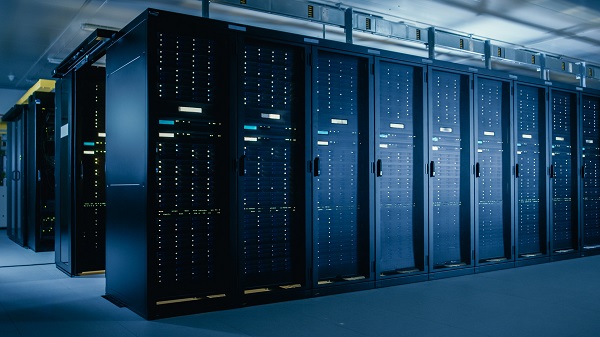
Data centers are the backbone of nearly every online activity, from streaming movies to managing global financial transactions. But what exactly is a data center, and why are they so critical? Simply put, a data center is a facility that houses the computing infrastructure powering modern businesses and technologies. It is the heart of data storage, processing, and distribution, enabling companies to deliver reliable services. Considering how important they are for supporting business operations, ensuring uptime, and enabling scalability, it is a good idea to know what is in a data center, how they work, and what types of data centers exist. This blog will cover these details, helping you understand this vital aspect of the modern digital era.
What Is a Data Center, and How Does It Work?
Types of Data Centers
-
Enterprise Data Centers: These are privately owned and operated by organizations to support their internal IT systems and applications. They are often located on company premises and provide complete control over infrastructure and security. While offering a high degree of customization, enterprise data centers require significant capital investment and maintenance.
-
Co-location Data Centers: A co-location data center allows businesses to rent space, power, cooling, and connectivity while hosting their equipment. This shared model reduces operational costs. It is ideal for businesses that don’t want to manage physical infrastructure but need some control over their servers and storage.
-
Cloud Data Centers: Operated by cloud service providers like AWS, Google Cloud, and Microsoft Azure, these data centers deliver scalable resources on demand. They are virtualized environments where businesses can store, process, and access data without managing hardware. Cloud data centers enable flexibility and rapid deployment but may involve ongoing subscription costs.
-
Edge Data Centers: These are smaller facilities located closer to end -users to reduce latency and improve performance. They support applications requiring real-time processing, such as IoT devices, 5G networks, and autonomous vehicles.
-
Hyperscale Data Centers: Built for massive scalability, hyperscale data centers cater to the needs of large tech companies like Facebook and Amazon. They use highly efficient architecture to handle enormous workloads.
How Are Data Centers Classified?
- Tier I: Basic Capacity
- Offers limited redundancy with minimal infrastructure for backup power and cooling.
- Uptime: ~99.67% (28.8 hours of downtime per year).
- Best suited for small businesses with minimal IT needs.
- Tier II: Redundant Capacity Components
- Provides partial redundancy in power and cooling systems.
- Uptime: ~99.75% (22 hours of downtime per year).
- Suitable for medium-sized businesses seeking improved reliability.
- Tier III: Concurrently Maintainable
- Allows for maintenance without disrupting operations due to full redundancy in power and cooling.
- Uptime: ~99.98% (1.6 hours of downtime per year).
- Ideal for organizations requiring high availability, such as financial institutions.
- Tier IV: Fault Tolerant
- Delivers the highest redundancy and fault tolerance level, ensuring continuous operation even during multiple failures.
- Uptime: ~99.99% (0.4 hours of downtime per year).
- Used by businesses with critical operations, such as healthcare and government agencies.
What Is in a Data Center?
A data center comprises various components that work in tandem to process, store, and transmit data securely and efficiently. These components are meticulously designed to ensure reliability, scalability, and performance.
Key Components Found in a Data Center
- Servers and Storage Systems:
- Servers are the primary computing units responsible for data processing and application hosting.
- Storage devices, such as Hard Disk Drives (HDDs) and Solid-State Drives (SSDs), provide scalable and secure storage for vast amounts of data.
- Advanced storage systems like Storage Area Networks (SANs) and Network-Attached Storage (NAS) enable efficient data management and retrieval.
- Networking Equipment:
- Routers, switches, and firewalls form the foundation of connectivity within the data center and between external networks.
- Firewalls offer protection against unauthorized access, while load balancers distribute network traffic efficiently to maintain performance and reliability.
- High-speed cabling connects servers, storage, and networking devices, ensuring seamless communication, and minimizing latency.
- Power Supply Systems:
- Continuous power is critical for uninterrupted operations. Data centers utilize Uninterruptible Power Supplies (UPS), backup generators, and redundant circuits to prevent outages.
- Power Distribution Units (PDUs) ensure electricity is distributed efficiently to all components.
- Cooling and Environmental Controls:
- Servers generate significant heat, necessitating robust cooling systems such as air conditioning, liquid cooling, and hot/cold aisle configurations.
- Proper airflow management and humidity controls maintain optimal environmental conditions, preventing overheating and hardware damage.
- Physical Security:
- To safeguard against physical threats, data centers employ advanced security measures like biometric access controls, surveillance cameras, and reinforced enclosures.
- Environmental monitoring systems and secure perimeters further enhance physical protection.
- Management and Monitoring Software:
- Infrastructure management tools provide real-time monitoring, enabling operators to track performance, detect issues, and optimize resource utilization.
- Automation software streamlines operations, automates repetitive tasks, and enhances overall efficiency.
Supporting Systems in a Data Center
- Redundancy and Failover Mechanisms:
- Critical systems, including power, cooling, and networking, incorporate redundancy to minimize downtime and ensure uninterrupted operations during component failures.
- Data Backup and Disaster Recovery:
- Backup systems and recovery protocols are implemented to safeguard data and maintain business continuity in case of failures or cyber incidents.
- Enhanced Cooling Solutions:
- Advanced technologies like liquid immersion cooling are employed in high-performance data centers to manage heat more effectively and improve energy efficiency.
By combining these components, data centers serve as the central hub for storing, managing, and transmitting data securely, making them indispensable to modern businesses and technological advancements.
How Data Centers Support Business Operations
Data centers are pivotal in supporting business operations. They are the foundation for essential IT services and digital transformation initiatives. Their ability to ensure reliability, scalability, and security is crucial for organizations across various industries.
- Business Continuity: Data centers are designed to minimize downtime and disruptions. They ensure uninterrupted operations even during emergencies with redundant power supplies, cooling systems, and failover mechanisms. This reliability supports critical processes, such as financial transactions and healthcare services, where downtime can have severe consequences.
- Scalability: Modern businesses need infrastructure that grows with their needs. Data centers enable scalability by allowing organizations to add servers, storage, and networking capabilities without significant delays. Scaling resources on demand is even more seamless for businesses using co-located data centers or cloud services.
- Global Connectivity: Data centers host networking infrastructure, facilitating communication and collaboration across locations. They also ensure smooth connectivity by enabling video conferencing for remote teams or supporting e-commerce platforms with global reach.
- Data Security and Compliance: Data centers implement robust physical and cybersecurity measures to protect sensitive information. They also help businesses comply with GDPR, HIPAA, and PCI-DSS regulations, reducing legal and reputational risks.
- Enhanced Performance: By hosting applications and data closer to end- users through edge data centers, businesses can reduce latency and improve the performance of real-time services like video streaming and IoT applications.
- Cost Efficiency: Companies using co-location data centers or cloud services reduce the overhead costs of maintaining on-premises infrastructure while accessing state-of-the-art facilities.
Future Trends in Data Centers
The role of data centers continues to evolve as emerging technologies, and growing demands reshape their design and functionality. Several trends are defining the future of data centers:
- Green Data Centers: Sustainability is becoming a top priority. Organizations are investing in renewable energy sources, energy-efficient cooling systems, and carbon-neutral designs. Green data centers aim to reduce the environmental impact of growing digital infrastructure.
- Edge Computing: With the rise of IoT and real-time applications, edge data centers are gaining prominence. These smaller facilities are closer to end- users, reducing latency and enabling faster data processing for autonomous vehicles and smart cities.
- AI and Automation: Artificial intelligence is used for predictive maintenance, resource optimization, and security enhancement. Automation tools manage workloads, monitor infrastructure, and proactively identify potential failures, reducing human intervention.
- Software-Defined Data Centers (SDDCs): SDDCs virtualize hardware resources, allowing for more flexible and scalable infrastructure. This approach streamlines operations, reduces costs, and improves agility for businesses adopting cloud-native technologies.
Conclusion
Data centers are indispensable in powering the digital age, serving as the backbone for many purposes: cloud computing, data storage, e-commerce, real-time applications, and more. Understanding what a data center is—and what its components and functions are—can help businesses make informed decisions about managing their IT infrastructure. This is especially important as data centers evolve and make use of edge computing, sustainable practices, and AI-driven automation. Businesses must keep pace with these advancements to stay competitive and continue meeting the growing demands of a connected world.
Thank you for trusting us to help with your technology needs. Contact us any time – we’re always happy to help.
Mike


